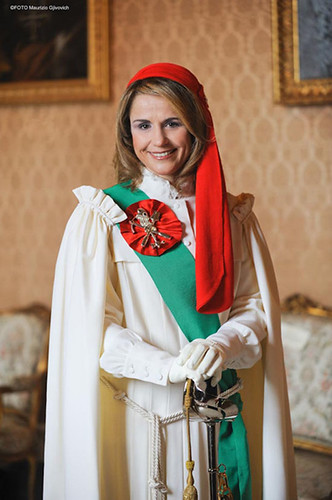Imagine oranges, the fruit whose juice will be handed to us if we reach far enough back in the refrigerator of our nearest supermarket. The peacefulness of an orange grove seems like it would be a place that, other than the buzzing of bees, would be a fairly peaceful and calming place to be.
Now, imagine a small Italian mountain village, with narrow cobblestone streets, small piazzas and a river running through it. Also, seems like a very peaceful and calming place. Birds chirping and the Alps looming in the distance all complete the small town where the smell of pizza is in the air.
However, when you combine the two, somehow, you end up with the best way to celebrate Carnivale… in the world
The next USAC journey took us to the town of Ivrea. Ivrea is a small town about an hour north of Torino by train. Ivrea spends 355 days a year in relative peace, but the 10 day festival known as Carnivale draws thousands of spectators and thousands of participants to the orange throwing battle that takes place in her streets. This battle has evolved into the largest food fight in Italy and one of the largest food fights in the world.
The origins of the festival are fairly unclear though the popular story is that back in the 12th century, a tyrant ruled the city. The Tyrant created a law that stated that he had the right to ask every newly wed woman in the city to spend a night with him. This jus primae noctis didn’t go over too well with the newly wed Violetta. When she was on her way to the castle the night of her wedding, she pledged to her new husband that she would not follow this rule. When the tyrant made his moves, she pulled a dagger from her dress and chopped of the tyrant’s head. The following morning, the head was displayed for the citizens to see. The citizens rejoiced and treated the head as a signal to revolt against the regime.
But where did the food come from? Once a year, around the time of the festival, the tyrant, in an attempt to appease his starving populace, would give them free beans (which has actually become one of the local dishes that we would spend part of the day searching for). Beans, by no stretch of the imagination, aren’t exactly a big deal so the commoners would, in a sign of total disrespect toward the tyrant, throw the beans all over the streets of the town.
 From Beans to Oranges is quite a stretch. According to common lore, every year, the town would celebrate their liberation from the tyrant with a parade. As the parade would pass by below, girls who wanted boys to notice them would toss oranges down from the balcony. Over time, the boys began to acknowledge the orange by tossing one back to the girl if they were interested as well. As time progressed, this developed into the full blown battle the Ivrea has become today.
From Beans to Oranges is quite a stretch. According to common lore, every year, the town would celebrate their liberation from the tyrant with a parade. As the parade would pass by below, girls who wanted boys to notice them would toss oranges down from the balcony. Over time, the boys began to acknowledge the orange by tossing one back to the girl if they were interested as well. As time progressed, this developed into the full blown battle the Ivrea has become today.  Over the last 204 years, the Carnivale of Ivrea has been one of the largest food fights in the world. Citizens of the town, visitors and whomever else can pay to join one of the nine teams on food. Each of these teams come from their own neighborhood of the town though, for people like me who visit the festival, this isn’t much of my concern. For 100 euros, one can join a team, throw all the oranges that they want for the 5 days of the battle as well as get into all the parties at night after the battle has come to a close. For those a bit more daring, 500 euros will get you into one of the carts that pass through the squares. The people in these carts represent the supporters of the tyrant. For 5 days, they throw oranges down onto the masses. Because they are the targets of thousands of orange throwers, they get masks and a bit of extra protection. Each year, the town elects a woman to play the part of Violetta. The woman can be placed into the pool of people to be elected from for a measly 80.000 euros. The Mugnaia pays for all the oranges used in the festival as well as the fireworks that take place at night after the battles come to a conclusion. When Napoleon came through, a general of his army wanted a bit of the action so he created the General and the General staff portion of the parade where, dressed in typical Napoleonic attire, they ride through the squares and are cheered at by the entire crowd. This position has become a very prestigious position for the people of Ivrea.
Over the last 204 years, the Carnivale of Ivrea has been one of the largest food fights in the world. Citizens of the town, visitors and whomever else can pay to join one of the nine teams on food. Each of these teams come from their own neighborhood of the town though, for people like me who visit the festival, this isn’t much of my concern. For 100 euros, one can join a team, throw all the oranges that they want for the 5 days of the battle as well as get into all the parties at night after the battle has come to a close. For those a bit more daring, 500 euros will get you into one of the carts that pass through the squares. The people in these carts represent the supporters of the tyrant. For 5 days, they throw oranges down onto the masses. Because they are the targets of thousands of orange throwers, they get masks and a bit of extra protection. Each year, the town elects a woman to play the part of Violetta. The woman can be placed into the pool of people to be elected from for a measly 80.000 euros. The Mugnaia pays for all the oranges used in the festival as well as the fireworks that take place at night after the battles come to a conclusion. When Napoleon came through, a general of his army wanted a bit of the action so he created the General and the General staff portion of the parade where, dressed in typical Napoleonic attire, they ride through the squares and are cheered at by the entire crowd. This position has become a very prestigious position for the people of Ivrea. Another extremely important figure is the substitute grand chancellor. The grand chancellor was one of the most important positions in the city, performing duties of a notary as well as maintaining the details of the cities activities. The person holding this position is always one of the most important people in the festival, other than the Mugnaia.
Our Journey brought us to the train station in Ivrea, which was surprisingly nice. Most of the train stations we have encountered in Italy to this point have been anything but nice so to see a nice train station was a welcome surprise. We received a little pep talk from Danielle about what to do and what not to do in Ivrea, who oranges can be thrown at and who oranges cannot be thrown at, where battles would be taking place and things of that nature. When he was done, we headed up the street and everybody purchased their Red safety hat and other articles of clothing and we walked to one of the main piazza’s that the battles would be taking place. Here is where the USAC group split. All around the piazza were stacks of oranges. It was quite a sight
We were on the hunt for the bean dish that is the local dish. Sadly, after walking around, we couldn’t find them so we had sandwiches from a cart. This made me think about Carson Valley days, standing in line for an Indian Taco or Lemonade… but any way, we also saw teams beginning to line up and get ready for battle
Before we parted from Danielle, he told us that the most intense battle would be the Ravens in a small square all by themselves. Though there would be 3 or 4 teams in some squares, those would be less intense because it is a massive square while the home of I Tuccini would be an intense battlefield. We made our way to the place of the ravens and I got some good pictures of people in their uniforms and the square. On the way, we also came a cross this giant Italian flag type thing.
We had been told that we wouldn’t be able to compete because the people who do throw oranges pay 100 euros and since we didn’t pay, we can’t play. With that in mind, I tried to find a good spot to get pictures from. I finally found a good place up in a balcony behind a restaurant that I snuck up to.
(pictures of my picture spot)
The rest of my group elected to stay below and try to secretly participate. As the battle started, I got a good number of pictures and some great video.
After a couple hours went by, I went down and joined in. I have never seen so much orange pulp in my life. It had to be calf deep in areas. At the end of the 5 days, the winning team is announced. The winner of the 204th annual orange throwing battle was the raven team, which was pretty cool.
We made our way back to the train station and got on the train for the hour-long train ride. Covered in orange pulp, peoples hair was solid, clothes wouldn’t bend and in general, people just felt gross. When we finally made it back to Torino, it was a race to get to the shower and get cleaned off. We had to take our clothes to be dry-cleaned but all in all, it was totally worth it. The Orange throwing battle in Ivrea is one of the coolest things I have gotten to do while studying abroad. If anybody gets a chance to do this, take it. You will not regret it, you will never forget it and you will have the time of your life. Having had the opportunity to see Carnival in both Venice and Ivrea, I would say that Ivrea’s rendition is far more awesome than Venice.
*Note: there should be a video from Ivrea up there but if there isn't one, then check back soon because I'm trying to get it up but, since I finally have space on my blog, I'm just trying to get these rolling!
*Note: there should be a video from Ivrea up there but if there isn't one, then check back soon because I'm trying to get it up but, since I finally have space on my blog, I'm just trying to get these rolling!























































No comments:
Post a Comment